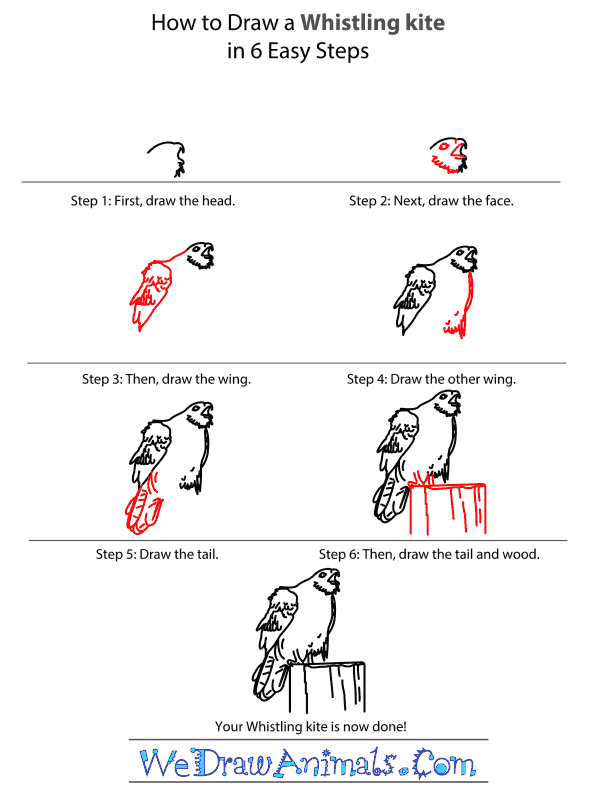In this quick tutorial you'll learn how to draw a Whistling Kite in 6 easy steps - great for kids and novice artists.
The images above represent how your finished drawing is going to look and the steps involved.
Below are the individual steps - you can click on each one for a High Resolution printable PDF version.
At the bottom you can read some interesting facts about the Whistling Kite.
Make sure you also check out any of the hundreds of drawing tutorials grouped by category.
How to Draw a Whistling Kite - Step-by-Step Tutorial
Step 1: Draw the head of your whistling kite. Include a hooked, sharp beak and a wide open mouth. This bird is named for its signature loud whistling call!
Step 2: Next draw the face. Add an eye, lines for the mouth and nose, and draw the feather line around the neck. It looks a lot like a beard.
Step 3: Draw the shoulder and wing. The wing has a W shape at the bottom and is rounded on top. Be sure to add feather details.
Step 4: Then draw a few lines to show the other wing, and the side of the bird's body.
Step 5: Now make the tail. The feathers are large and shaped a lot like fingers! Add lines to show detail.
Step 6: Now draw the legs and feet. These birds have short legs but strong feet to snatch prey right off the ground as they fly! Draw a tree stump for your whistling kite to stand on and you are finished! If you'd like to color your bird, it is light brown close to the center of its body and has darker feathers the farther out you go.
Interesting Facts about the Whistling Kite
A common site across Australia, New Guinea, and New Caledonia the Whistling Kite is well known for the unique whistling noise it makes in flight. The Whistling Kite has a shaggy appearance, with a nearly bald head, it’s also a small for a raptor. They only grow to be two feet tall with a five foot wing span that’s slightly bowed.
Did you know?
- Spotted bowerbirds regularly mimic the cry of the Whistling Kite, doing it more frequently the closer to the Whistling Kite’s breeding season.
- Whistling Kites are monogamous, mating pairs stay together in an area for years, reusing the same nest that they continue building for years.
- Whistling Kites have adjusted to human’s well, using farmland for hunting grounds and feeding on road kill.
- Whistling Kites have been known to steal food from other raptors and waterbirds forcing them to regurgitate their food.
- They will move in large groups during nomadic movements but otherwise stick to their own areas and mating pairs.
Lesson plan note: Whistling Kites travel in large groups during their migration. Print out enough blank pictures of a Whistling Kite for every student in the class and have them color their own Whistling Kite. Then staple all of the birds at the front of the classroom to create a classroom Whistling Kite group.







